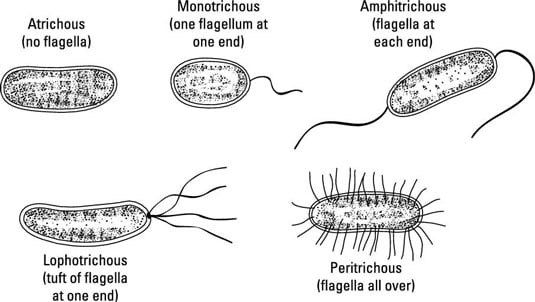Describe the Different Means of Locomotion Used by Prokaryotes
In b transduction a bacteriophage injects DNA into the cell that contains a small fragment of DNA from a different prokaryote. The organs for locomotion are cilia and flagella.
Describe the Different Means of Locomotion Used by Prokaryotes.

. Amoeboids have extensions of. Protozoa are eukaryotic organism having specialized organs for locomotion. The most common type of movement in prokaryotes is through flagellar action.
This membrane allows them to. Prokaryotic cells have different characteristic features. Ribosomes are cell structures responsible for protein production.
-Long helical structures -Composed of the protein flagellin-Involved in locomotion. Flagella are used for locomotion while most pili are used to exchange genetic material during a type of reproduction called conjugation. Some microbial cells are stationary but most of them have a means of getting around called locomotion.
In c conjugation DNA is transferred from one cell to another. Flagella are long whip-like protrusions that aid in cellular locomotion. We went over three types of locomotion.
Entamoeba histolytica-locomotion is by the movement of the ectoplasm producing projections called pseudopodia false feet. Flight swimming and land locomotion. Thus in different prokaryotes locomotion vary which depends.
The flagella differs in. Prokaryotes show Flagellar locomotion. The prokaryotic cell has several elements that allow it to function as a living organism.
Surrounds the cells cytoplasm and regulates the flow of. Flight is the motion of an animal through the air. Locomotion by Mucilage Propulsion.
Flagella are used for locomotion while most pili are used to exchange genetic material during a type of reproduction called conjugation. First prokaryotes are covered in a cell membrane. They lack a nuclear membrane.
Explain the different means by which bacterial cells are able to move. Ectoplasm outer layer involved in locomotion feeding and protection like an amoeba Endoplasm. Each has little hair-like.
2Trypanasoma Gambiense- locomotion is by the use of. They propel the cell forward. A few forms can move by gliding or floating although the vast majority move by means of whips or small hairs known as flagella or cilia respectively.
Long whip-like protrusion that aids cellular locomotion used by both gram positive and gram negative organisms. Ciliates such as the little paramecium pictured here are the largest of the bunch. Those organelles give their names to.
Birds are probably the most famous example. Flagella are important for movement. 3 Methods of Protist Locomotion Ciliates.
Plasmids are gene. In this article we will discuss about the four main types of locomotion in protozoa. Protozoans exhibit diverse modes of locomotion across the various groups but the modes of locomotion can be broadly divided into flagellar ciliary and amoeboid movement.
They show whip like movement of the flagella which helps in movement of the organism in fluid medium. Front left and back right followed by front right and back left. Describe strategies employed by.
Some prokaryotes have flagella pili or fimbriae. The trot is different from a walk in that the animal moves opposing diagonal limbs in tandem ie. A flagellum plural flagella is a long appendage specialized for locomotion and while both.
Other Apps - April 17 2022 The information below was adapted. Granular inner region house the nucleus mitochondria and food and contractile. The trot is a.
Answer 1 of 2. The characteristics of the prokaryotic cells are mentioned below.

Live And Learn Press Biology Learn N Folder Notebook Biology Lessons Middle School Science Experiments Teaching Biology



Comments
Post a Comment